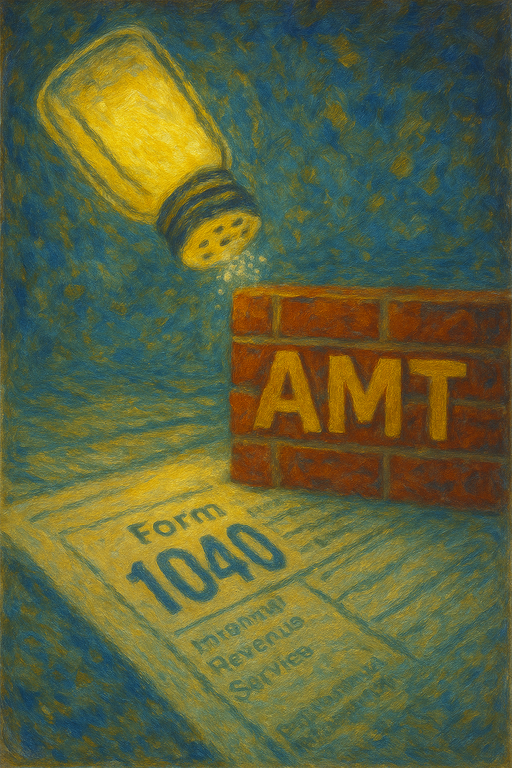Q: What happens to my taxes when the Tax Cuts and Jobs Act expires after 2025?
A: They almost certainly go up. The 20% QBI deduction vanishes, tax brackets shift higher, AMT thresholds plunge, the standard deduction shrinks, and dozens of “temporary” breaks end – unless Congress extends the legislation.
TL;DR
- QBI gone. Pass-through owners lose the 20% bonus deduction – worth six figures for high-earners.
- Higher brackets. Top rate jumps back to 39.6%; all brackets slide downward.
- AMT strikes back. Exemption drops from $1M / $500k MFJ/Single to ≈ $164k / $120k (inflation adjusted).
- Standard deduction halves, but personal exemptions return and Itemized-vs-Standard calculus flips again.
- Child Tax Credit decreases 50% and phaseouts tighten.
- Bonus depreciation fades to 0% by 2027; Section 179 remains.
- Estate exemption drops from $13.99M to ≈ $7M (inflation adjusted).
- SALT cap disappears, but AMT will claw much of it back for upper-income filers.
Since 2018 we have been under provisions from the Tax Cuts and Jobs Act (TCJA). This legislation was the biggest change to the tax code in over 30 years – and I saw firsthand a decent number of accountants who were already close to retirement age decide to hang up their hats a few years early rather than learn about and deal with these changes.
Well now a lot of those provisions are set to expire.
Many of the changes from this legislation only ran from the 2018 to 2025 tax years. If the legislation is not extended, then starting next year we will revert to pre-2018 rules.
So what will that look like?
Caution: I want to note very specifically that this is an analysis of the tax code comparing the differences between existing law. It is possible that Congress will choose to extend or adjust some of these provisions before they expire.

20% Qualified Business Income Deduction (QBI)
The biggest change our clients are going to have to contend with is the expiration of the Qualified Business Income Deduction (QBI).
Pass-through entities (S-Corps, sole proprietorships, partnerships, or LLCs taxed as S-Corps, sole proprietorships, or partnerships) have been eligible for a Qualified Business Income Deduction (QBI) of up to 20% on their profits. So, if your business had a $100,000 profit you would be eligible for an up to $20,000 bonus deduction.
One major caveat to this is that at higher income levels (~$200k for single filers and ~$400k for married filers) the deduction gets phased out and is subject to a threshold of the greater of 50% of the business’s W-2 wages or 2.5% of its depreciable property. To give another example: imagine two companies who each have $1,000,000 profit. Each company would be allowed an up to $200,000 QBI deduction. But Company A only has wages of $100,000 and Company B does not have any W-2 employees at all. Company A would only receive a $50,000 QBI deduction (50% of $100,000) and Company B would not receive any deduction at all (50% of $0).
Because of those phaseouts, salary planning to optimize for QBI has been an important part of tax planning.
The expiration of QBI will mean two things:
- All taxpayers with businesses are going to have their taxable incomes increase substantially
- The QBI optimization portion of tax planning will be eliminated
Especially for high-earners, the loss of QBI cannot be overstated. Optimizing for QBI can literally save taxpayers hundreds of thousands of dollars.
Higher Individual Tax Rates
The TCJA reduced the top individual tax rate from 39.6% to 37%. It also reduced tax brackets across all income levels somewhat as well.
These are set to revert to their pre-TCJA levels after 2025.
The exact thresholds will be adjusted for inflation, but here is a comparison of pre-TCJA and post-TCJA tax brackets from our analysis when the legislation first came out in 2017:
| Single Taxpayers | ||||||
| Pre-TCJA | Post-TCJA | |||||
| 10% | $0 | $9,325 | 10% | $0 | $9,525 | |
| 15% | $9,326 | $37,950 | 12% | $9,526 | $38,700 | |
| 25% | $37,951 | $91,900 | 22% | $38,701 | $82,500 | |
| 28% | $91,901 | $191,650 | 24% | $82,501 | $157,500 | |
| 33% | $191,651 | $416,700 | 32% | $157,501 | $200,000 | |
| 35% | $416,701 | $418,400 | 35% | $200,001 | $500,000 | |
| 39.6% | $418,401+ | 37% | $500,001+ | |||
| Married Filing Jointly Taxpayers | ||||||
| Pre-TCJA | Post-TCJA | |||||
| 10% | $0 | $18,650 | 10% | $0 | $19,050 | |
| 15% | $18,651 | $75,900 | 12% | $19,051 | $77,400 | |
| 25% | $75,901 | $153,100 | 22% | $77,401 | $165,000 | |
| 28% | $153,101 | $233,350 | 24% | $165,001 | $315,000 | |
| 33% | $233,351 | $416,700 | 32% | $315,001 | $400,000 | |
| 35% | $416,701 | $470,700 | 35% | $400,001 | $600,000 | |
| 39.6% | $470,701+ | 37% | $600,001+ | |||
Alternative Minimum Tax Threshold (AMT) Decrease
One of the biggest issues that I’m not hearing enough people talk about is the Alternative Minimum Tax (AMT) thresholds drastically decreasing back to pre-TCJA levels.
AMT is a tax calculation that runs parallel to the normal tax code. In theory, it is designed to increase the tax wealthy people pay. Once taxpayers reach certain income thresholds, some of the deductions they were able to take previously are limited or disallowed entirely.
The issue with AMT is that it was enacted in 1969, but did not begin to be adjusted for inflation until 2013. Because of this, a lot of middle-class families ended up paying it.
The TCJA increased the AMT threshold from $120,700 to $500,000 for single taxpayers and from $160,900 to $1 million for married taxpayers.
If those thresholds revert to pre-TCJA levels (as they are scheduled to do) the number of people paying AMT will increase substantially. The Tax Policy Center estimated that the number of taxpayers paying AMT decreased a whopping 96% under the TCJA.
Standard Deduction Decrease
The TCJA roughly doubled the standard deduction. As an example, the 2017 standard deduction was $6,350 for single filers and $12,700 for married couples. The 2018 standard deduction was $12,000 for single filers and $24,000 for married couples.
The standard deduction is set to revert – adjusted for inflation – back to those pre-2018 levels.
This sounds bad, but it is not as detrimental as it may sound on its face. Because of the increased standard deduction, far fewer taxpayers now itemize. Pre-TCJA, 30.6% of taxpayers itemized on their individual return. By 2018 that dropped to 11.4% and by 2021 it had dropped to 9%.
With the decrease of the standard deduction – along with some limitations to itemized deductions also set to expire – it will give more taxpayers the opportunity to itemize.
Even for those who don’t, the decreased standard deduction will largely be offset by:

Personal Exemptions Returning
Pre-TCJA you were able to claim a deduction for $4,050 for each person in your household. The TCJA eliminated this entirely. These exemptions are set to return beginning in 2026. If they do, it is estimated they will be about $5,300 per person.
This would be great news for parents except for:
Decreased Child Tax Credit
The TCJA increased the child tax credit from $1,000 to $2,000 per child. This is set to revert back to $1,000 per child.
That on its own is unfortunate, but the bigger issue is the income phaseouts of those credits.
Pre-TCJA the income phaseouts were much more limited. Currently the income phaseout threshold is $200,000 if you are single and $400,000 if you are married. At pre-TCJA levels those thresholds are only $75,000 for single filers and $110,000 for married filers.
So not only will the tax credit be half of what it currently is, your chances of being able to claim all of it will be drastically decreased. By some estimates, the number of taxpayers who were able to claim the child tax credit nearly doubled under the TCJA – from 22 million taxpayers pre-TCJA to over 40 million during the TCJA.

State and Local Tax (SALT) Cap Goes Away
Pre-TCJA you were able to deduct all of the state and local taxes you paid as an itemized deduction on Schedule A. This upset the majority of states with an income tax, so as a partial workaround most created some form of Pass-Through Entity Tax (PTET) election. This SALT cap is set to expire after 2025 and you will be able to deduct the full amount of state and local tax you pay.
Unfortunately, this sounds better in theory than it functions in practice. This is because of the decreased AMT thresholds we discussed earlier in the article.
There are a number of items that are adjusted when calculating AMT, but one of the main ones is that the SALT deduction is disallowed.
One analysis found that taxpayers that paid AMT pre-TCJA still paid less tax under the TCJA – even with the SALT cap.
Deductible Mortgage Interest Threshold Goes Up
Prior to the TCJA, you were able to deduct interest on mortgages up to $1 million. For mortgages obtained after 12/15/2017, this limit was reduced to $750,000.
This limit is set to revert to $1 million, but that will only be for mortgages obtained 2026 or later. For mortgages obtained between 2018 and 2025, the limit will remain at $750,000.
Taxpayers with large mortgages could in theory refinance after 2025 to bypass this limit. But given the interest rates for the majority of the TJCA period compared to now, that is unlikely to make sense unless current interest rates drop significantly.

Bonus Depreciation Going Away
This is actually a change we’ve been slowly feeling the effects of for the past few years. From 2018-2022 you were able to fully depreciate 100% of a qualifying asset’s purchase price in the first year. That has since been going down and will be fully eliminated come 2027:
| Tax Year | Bonus Depreciation Percentage |
| 2018–2022 | 100% |
| 2023 | 80% |
| 2024 | 60% |
| 2025 | 40% |
| 2026 | 20% |
| 2027 | 0% |
Even with this going away, Section 179 depreciation is still available. The loss of bonus depreciation will still affect taxpayers purchasing certain types of assets or a very high dollar amount of assets. But for many asset classes, Section 179 will still function as a full replacement for bonus depreciation.

Estate Tax Exemption Decreasing
The TCJA roughly doubled the estate tax exemption. In 2017 the exemption was $5.49 million per person and increased to $11.2 million in 2018. It now sits at $13,990,000. Come 2026 it will revert back to pre-TCJA levels (adjusted for inflation), with some estimates having that in the neighborhood of $7 million per individual.
Obviously, this will not affect the vast, vast majority of taxpayers. In 2017 only 12,700 estate tax returns were filed compared to 8,130 returns in 2022. So the effect of this change will be narrow.
The estate tax used to be a much bigger deal and would affect everyday households. In 2001 the estate tax exemption was only $675,000 and over 108,000 estate tax returns were filed.
Itemized Deduction Cap (Pease Limitation) Returning
The Pease limitation reduced certain itemized deductions for high-income taxpayers (AGI of $261,500 for single filers and $313,800 for married couples). The affected itemized deductions were:
- Mortgage interest
- SALT taxes
- Charitable contributions
- Miscellaneous itemized deductions (2% of AGI floor)
The way the Pease limitation worked is that for every dollar beyond the threshold, itemized deductions were reduced by three cents. This 3% reduction continued to a maximum reduction of 80% of a taxpayer’s itemized deductions.
This limitation was suspended during the TCJA and is set to return (adjusted for inflation) in 2026.
Other Miscellaneous Changes
There are some other changes set to take effect, although for most people they will be less impactful than the changes noted above. The ones that are more of note are:
- Miscellaneous itemized deductions returning. The TCJA eliminated all miscellaneous itemized deductions subject to a 2% of AGI floor. These included:
- Unreimbursed employee expenses
- Tax preparation fees
- Investment advisory fees
- Certain legal fees
- Safe deposit rentals
- Casualty and theft losses (under the TCJA these were only allowed for business/profit-motive losses or Ponzi scheme thefts)
- Hobby expenses (to the extent of hobby income)
- Moving expenses are returning. The TCJA eliminated moving expenses as a deductible expense unless you were active-duty military. This was an especially helpful deduction because – unlike the 2% of AGI miscellaneous deductions – there is no floor and it also does not require you to itemize. These are “above-the-line” deductions that are calculated before AGI. This moving expense deduction is set to return come 2026.

Conclusion
The TCJA was major legislation that shifted the entirety of the tax planning landscape. Its sunset will be just as impactful. Make sure you are doing careful planning with your CPA to strategize for these changes. Keeping the same strategies from 2018-2025 could cost you dearly.
FAQ
How much will losing QBI really cost?
A pass-through earning $400k now gets a deduction of up to $80k via QBI. That deduction disappears in 2026 – raising the top federal rate significantly on that income slice.
Who gets hit hardest by the AMT threshold drop?
Upper-middle-income families in high-tax states. The exemption will shrink to roughly $120k (single) / $164k (MFJ), pulling millions back into AMT for the first time since 2017.
Will the Child Tax Credit really fall to $1,000?
Yes, unless Congress extends it. Phase-outs also revert to ≈ $75k/$110k (single/MFJ), meaning far fewer families will qualify.
Does the SALT cap going away solve the problem for high-income taxpayers?
Partially. You can deduct full state taxes again, but AMT disallows SALT entirely – so many upper-income filers will still see no benefit.
Should I accelerate equipment purchases before bonus depreciation ends?
If cash-flow allows, yes – bonus depreciation is 60% in 2024, 40% in 2025, 20% in 2026, and 0% after that. Section 179 helps, but has asset-type and income limits.
Any accounting, business, or tax advice contained in this communication, including attachments and enclosures, is not intended as a thorough, in-depth analysis of specific issues, nor a substitute for a formal opinion, nor is it sufficient to avoid tax-related penalties.






